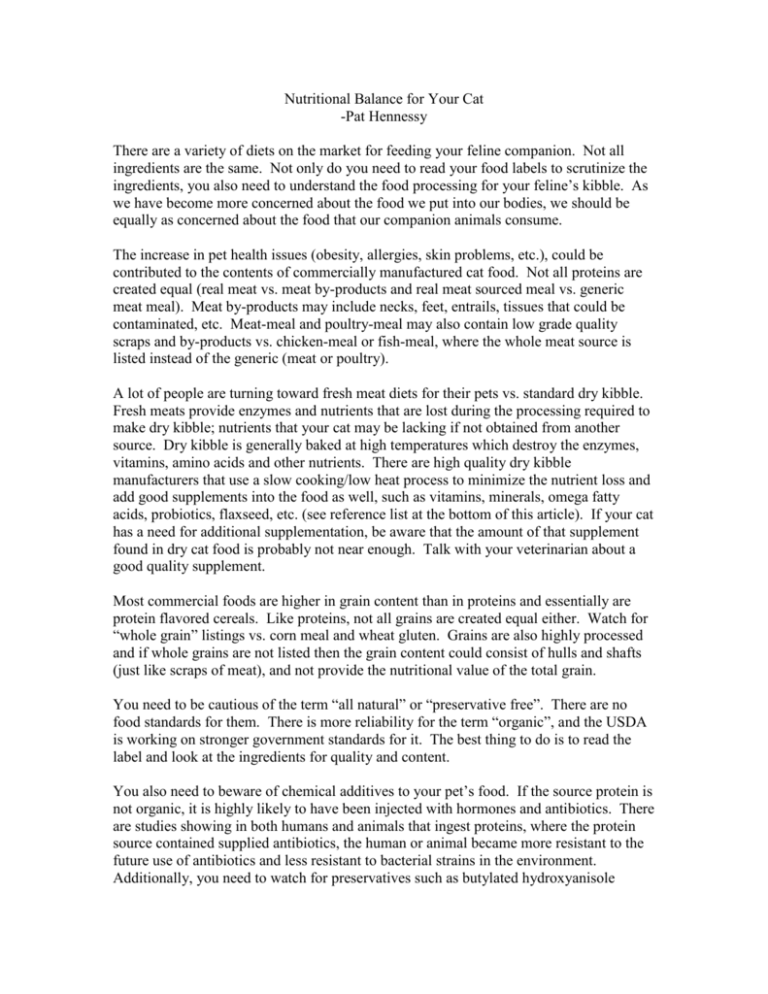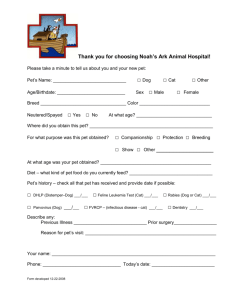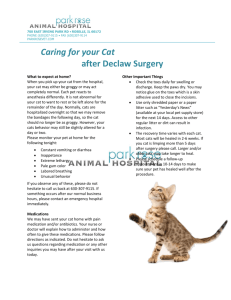
Nutritional Balance for Your Cat
-Pat Hennessy
There are a variety of diets on the market for feeding your feline companion. Not all
ingredients are the same. Not only do you need to read your food labels to scrutinize the
ingredients, you also need to understand the food processing for your feline’s kibble. As
we have become more concerned about the food we put into our bodies, we should be
equally as concerned about the food that our companion animals consume.
The increase in pet health issues (obesity, allergies, skin problems, etc.), could be
contributed to the contents of commercially manufactured cat food. Not all proteins are
created equal (real meat vs. meat by-products and real meat sourced meal vs. generic
meat meal). Meat by-products may include necks, feet, entrails, tissues that could be
contaminated, etc. Meat-meal and poultry-meal may also contain low grade quality
scraps and by-products vs. chicken-meal or fish-meal, where the whole meat source is
listed instead of the generic (meat or poultry).
A lot of people are turning toward fresh meat diets for their pets vs. standard dry kibble.
Fresh meats provide enzymes and nutrients that are lost during the processing required to
make dry kibble; nutrients that your cat may be lacking if not obtained from another
source. Dry kibble is generally baked at high temperatures which destroy the enzymes,
vitamins, amino acids and other nutrients. There are high quality dry kibble
manufacturers that use a slow cooking/low heat process to minimize the nutrient loss and
add good supplements into the food as well, such as vitamins, minerals, omega fatty
acids, probiotics, flaxseed, etc. (see reference list at the bottom of this article). If your cat
has a need for additional supplementation, be aware that the amount of that supplement
found in dry cat food is probably not near enough. Talk with your veterinarian about a
good quality supplement.
Most commercial foods are higher in grain content than in proteins and essentially are
protein flavored cereals. Like proteins, not all grains are created equal either. Watch for
“whole grain” listings vs. corn meal and wheat gluten. Grains are also highly processed
and if whole grains are not listed then the grain content could consist of hulls and shafts
(just like scraps of meat), and not provide the nutritional value of the total grain.
You need to be cautious of the term “all natural” or “preservative free”. There are no
food standards for them. There is more reliability for the term “organic”, and the USDA
is working on stronger government standards for it. The best thing to do is to read the
label and look at the ingredients for quality and content.
You also need to beware of chemical additives to your pet’s food. If the source protein is
not organic, it is highly likely to have been injected with hormones and antibiotics. There
are studies showing in both humans and animals that ingest proteins, where the protein
source contained supplied antibiotics, the human or animal became more resistant to the
future use of antibiotics and less resistant to bacterial strains in the environment.
Additionally, you need to watch for preservatives such as butylated hydroxyanisole
(BHA), butylated hydroxytoluene (BHT), and ethoxyquin as well as artificial colors and
flavors, and chemicals such as propylene glycol (used to keep “chewy” foods moist).
These preservatives have been blamed for cancer, kidney & pancreatic disease, blindness,
and immunodeficiency, which lead to allergies, hair loss and other illnesses. Studies are
being conducted by the Pet Food Institute and Monsanto (ethoxyquin manufacturer) to
determine what levels of artificial preservatives are safe. The FDA also requested that
the artificial preservative manufacturers lower the maximum levels from 150 parts per
million (ppm) to 75 ppm.1
Kibble can be naturally preserved with tocopherols (Vitamin E), ascorbic acid (Vitamin
C), or by using oxygen barrier packaging. If you choose to go with naturally preserved
pet food, then your cat must consume all of the food within 4-6 months of the
manufacturer’s date. If you cannot find or interpret the date, call the manufacturer.
Sweeteners are another item to avoid in dog or cat food. It may be listed in the form of
corn syrup, sucrose or ammoniated glycyrrhizin. They are added to make the food more
palatable.2 Sweeteners are not something that should be part of your pet’s diet. It is not
necessary and can encourage conditions such as diabetes.
Make sure you consistently observe your cat. His diet will be reflected in his coat, skin
and energy level, as well as the presence (or absence) of diarrhea, constipation, vomiting,
freshness of breath and potentially behavior problems. There are links to behavioral
issues due to nutritional deficiencies, that are shown to be decreased or eliminated when
the cat is supplied a nutritionally balanced diet.
The best thing to remember is to look for good sources of protein, whole foods and
natural preservation vs. additives. The more nutrient dense the food is (appropriate
balance and quality of meat & vegetables vs. grains); the more digestible it will be for
your feline companion. The more digestible the food is, the more the body will utilize it
and less waste is produced. The difference in cost for high quality food is well worth it in
the health of your cat.
Pat Hennessy, is the founder of N2paws, LLC, an organization that provides companion
animal attunement through behavior analysis, energy work, and Tellington TTouch. Pat
is a certified TTouch practitioner, certified pet dog trainer (CPDT) and member of the
Association of Pet Dog Trainers (APDT), the International Association of Animal
Behavior Consultants (IAABC), and Animal Wellness Association (AWA). You may
contact N2Paws via email pat@n2paws.com, phone 816-522-7005, or visit the website
www.n2paws.com
Copyright 2006 N2paws LLC, Kansas City, MO All rights reserved
1
2
Dr. Lisa Freeman, DVM veterinary clinical nutritionist at Tufts University
Whole Dog Journal March 2000
Nutrition Recommendations (for dry kibble)
Pet Foods
Highest Quality (Higher Cost)
o Locations
Barkery & Bath (Brookside, Olathe & Lee’s Summit)
Natural Pet Food & Supply (Leawood & Lawrence)
Go Pet Go & Shoal Creek Animal Clinic (KC North & Liberty)
o Foods
Nutura (Innova, Evo, California Natural), PetCureen/Go,
Evanger’s, Azmira, PureVita, etc.
High Quality (Medium Cost)
o PetCo or PetSmart
Wellness, Solid Gold, Nature’s Recipe, Natural
Balance (Dick Van Patton’s food)
Medium/Lower Quality (Medium to Lower Cost)
o No one brand recommended
Read the label to watch for filler ingredients
(corn, wheat, gluten, etc.)
Read the label to watch for chemical preservatives
Look at first ingredients listed
Alternative Choices for Dry Kibble
Make your own
o Commercial preparations where you add the protein
source
Honest Kitchen & Urban Wolf
o Meats, vegetables & digestible grains, like oats (or no
grains), add bone meal for calcium
Buy raw and mix veggies with it (veggies should be steamed
and added to food)
o Some good veggie choices for cats would be:
Potatoes (sweet, red, or white), peas, carrots,
squash
.




